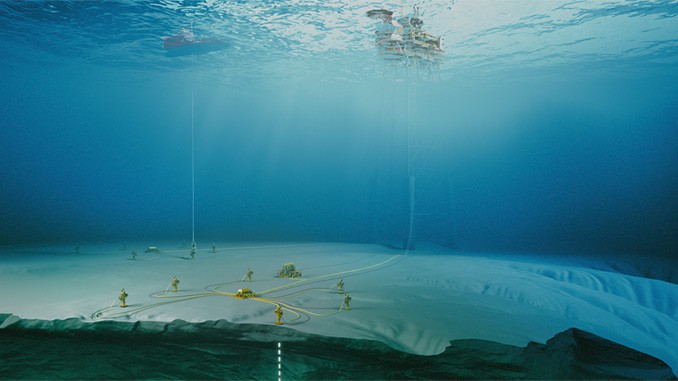Well Control Incident: Subsurface Uncertainties, Unfamiliar Technologies, & Shallow Water Flows in a Subsea Exploration Well

During the drilling of top-hole sections on a subsea exploration well, a series of water flows were encountered.
A number of lessons were identified relating to subsurface uncertainties, well planning, and the detection of well water flows, while operating with a mud recovery system during riserless drilling operations:
- The importance of understanding and planning for subsurface uncertainties in well operations.
- Risks associated with the implementation of new technologies in well operations, including the management of risks with crew’s knowledge, skills and ability.
Subsurface uncertainties, unfamiliar technologies and shallow water flows in a subsea exploration well
The top-hole section was drilled to TD with seawater and sweeps prior to displacing to 1.32sg (11ppg) mud. A shallow water flow was encountered during the trip-out but the well was killed using a number of heavy pills up to 1.60sg (13.3ppg). Due to concerns about the hole conditions the decision was taken to abandon the hole section and re-spud the well.
Drilling the drilling of the new top-hole section a similar mud weight of 1.32sg (11ppg) was used but with a revised plan for a shallower section depth. However, before the revised section depth was reached an unexpected flow was detected. It was necessary to increase mud weight first to 1.38sg (11.5ppg) and then to 1.47sg (12.2) prior to pulling out of the hole. A decision was then made to change the 28” liner casing depth.
Shortly after drilling out the liner with a 1.43sg (11.9ppg), a mud shallow water flows was encountered. Attempt to kill the well with a 1.51sg (12.6ppg) mud was unsuccessful. Eventually, the flow was controlled with 1.55sg (12.9ppg) mud but with slight losses occurring.
What went wrong?
- A permeable sand formation, capable of flow in the first top-hole section, had not been expected during planning of the well. This same formation with flow occurred again during the re-spud activities. The well plan did not account for this formation and pore pressure regime.
- The first top-hole section inadvertently drilled into the top, higher pressure, sand formation that was different to the seismic event from the reference well.
- Pore pressures encountered were 60-100psi higher than predicted.
- Well flow detection techniques were compromised whilst drilling:
- The flow check procedure, adapted for use with the mud recovery system during riserless drilling, was not fully documented nor understood by the team. This was subsequently addressed on the re-spud.
- Well monitoring was complicated when using seawater and sweeps with the mud recovery system in exhaust mode masking well flow events.
- Traditional flow detection techniques, e.g. bubble monitoring, that have been proven elsewhere in the region were not applicable on this well. Gas bubbles were not seen in association with shallow water flows.
Corrective actions and recommendations
- Multiple compaction trends and geological scenarios should be considered to support a larger, but still reasonable, pre-drill PPFG uncertainty range
- Credible worst-case pore pressures with mitigation action should be included in the well plan.
- Advances in seismic interpretation tools and technology should be used when determining overburden pressures.
- Operational safety briefings and training should include awareness that wildcat well tops determined from seismic may not correspond directly to expected lithology and pressure.
- Well design should be updated to enable sufficient standoff to avoid penetrating the Top sand with the 28” casing setting depth. The seismic event pick for the Top sand formation should also be updated.
- Develop standard wellbore monitoring procedures when drilling top hole with riserless mud recovery systems and crew resource management training on the following:
- The lack of bubbling is not an indicator of no-flow
- Even with good visibility, ROV flow checks need corroboration with mud recovery system pressure data
- Procedure for flow checking with mud recovery system
- ECD and sand mining are indicators of flow
- Operational requirement and procedures to pump out of hole
- Staged approach to well kill to allow determination of pore pressure
- The drill bit should be recovered above the wellhead when anticipating extended waiting periods; especially if bad weather is expected (swab risk). The ROV should be deployed to periodically monitor valves.
Source: IOGP Well Control Incident Lesson Sharing, 21-8, International Association of Oil & Gas Producers.
Circumstances can crop up anywhere at any time if proper and safe sequence and procedures are not planned and followed. We encourage you to learn and use the TapRooT® System to find and fix problems.
TapRooT® has a team of investigators and instructors with years of extensive training ready to offer assistance worldwide. We also offer ongoing support to our clients through free newsletters and root cause tip videos, the root cause analysis blog, and our annual Global TapRooT® Summit.
Register for one of our courses. We offer a basic 2-day course and an advanced 5-day course. Contact us or call 865.539.2139 about having a course at your site or for further root cause analysis opportunities. We’re here to find solutions for you.
Contact us to discuss training your employees on-site. You may also call us at 865.539.2139 to speak to an instructor, schedule an executive briefing, or book on-site training for your team.



